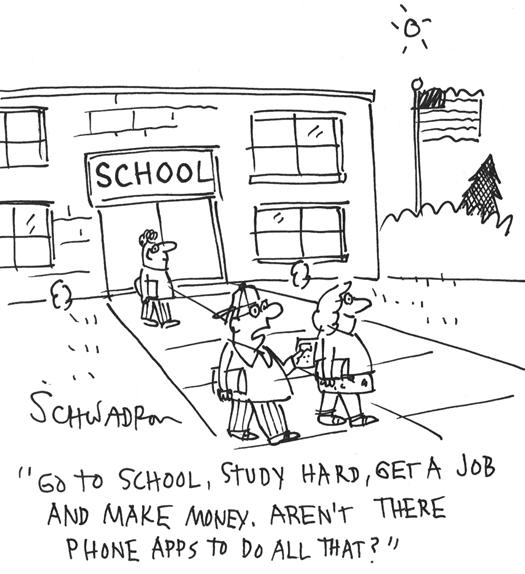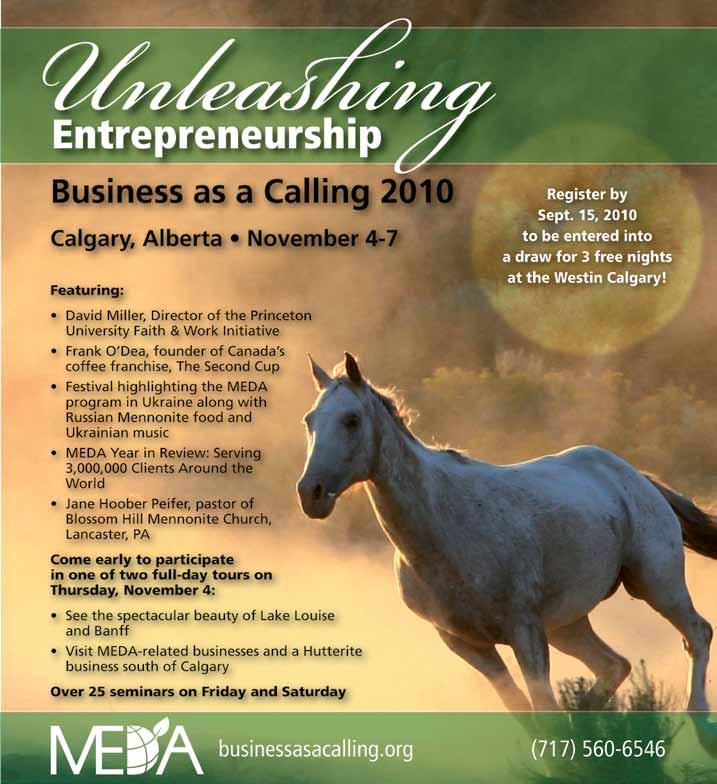
7 minute read
News
MEDA convention: unleashing the spirit in Canada’s west
In a post-economic crisis world there is a great need to set free the innovative spirit of business — hence the theme for MEDA’s Business as a Calling convention, titled Unleashing Entrepreneurship.
The convention will be held Nov. 4-7 in Calgary.
“Like MEDA, Calgary is renowned for its spirit, energy and innovation,” says convention planner Howard Good. “It’s a fitting environment to focus on unleashing entrepreneurship.”
The convention, MEDA’s largest annual public event, is designed for people who want to connect their faith with their work and who support MEDA’s mission of creating business solutions to poverty.
Keynote presentations are slated for the Thursday, Friday and Saturday evening sessions, as well as the Sunday morning worship. • David Miller, director of Princeton University’s Faith & Work Initiative and author of God at Work: The History and Promise of the Faith at Work Movement, brings a unique perspective to workplace issues. A former executive and entrepreneur — now a theologian and ethicist — he will talk about “Succeeding without selling your soul: Spiritual and ethical grounding for entrepreneurs.” • A festive evening of Russian Mennonite food and Ukrainian music will set the stage for a lively update on MEDA’s entrepreneurial project in Ukraine, where smallholder farmers are being helped to rejuvenate land once tilled by Mennonites. Winnipeg businessman Fred Wall will describe his search for family roots and business connections in Ukraine. Project manager Steve Wright will present highlights from the Ukraine Horticulture Development Program. • Motivational speaker Frank O’Dea will share his personal experience of the power of business to alleviate poverty. He overcame adversity to transform himself from a street panhandler to become founder of Canada’s Second Cup coffee franchise, now a chain of 70 stores across the country. His topic will be “From homelessness to entrepreneurship: The power of hope, vision and action.” • Pennsylvania pastor Jane Hoober Peifer, who grew up in a business family, will speak on “Unleashing the Spirit of God in the life of the entrepreneur.” She will explore how the creative mind and spirit of the entrepreneur mirrors the creative energy of God in the world.
The convention also features opportunities for professional development, networking and in-depth exploration of the faith/business connection. More than 30 seminars will be offered, including: • From Wall Street to the farm • Father, son and company • Oil and gas in Alberta: Boom or bust • Staircase out of poverty in Haiti • From the tractor to the boardroom • Opportunities in the business of health • A conversation with Alberta writer Rudy Wiebe, one of Canada’s leading novelists
Local tourist options range from visits to the spectacular scenery of Banff and Lake Louise in Canada’s Rocky Mountains to tours of local businesses, including the Bernard Callebaut chocolate factory, Alberta Boots and Hats, and a chance to learn “curling,” Canada’s favorite participant sport.
For more information or to register, call 1-800-665-7026 or go to businessasacalling.org

Making plant safety a state of mind
Having a good safety policy is one thing, but getting employees to buy in is something else. Efforts to do so at a Pennsylvania meat-products company were profiled recently in The Ragan Report, a leading magazine for corporate communicators.
The publication featured the communications strategy of Hatfield Quality Meats (the chief subsidiary of the Clemens Food Group). The strategy is credited with helping the company reduce its serious accidents by one-third from 2007 to 2009.
“One of the biggest things you must do is to engage every employee,” the magazine quotes Eric Haman, Hatfield’s corporate communications
continued on page 23
Move over famine; Africa emerging as a good news story
It used to be called “the hopeless continent,” but when it comes to bouncing back from the global recession, Africa is doing quite well, according to Mthuli Ncube, chief economist of the African Development Bank (ADB).
He predicts the continent will chalk up a growth rate of 4.5 percent this year, five percent next year, and then resume its pre-recession rate of six percent.
“Africa is leading, believe it or not, global economic recovery in the sense of being such a strongly recovering zone compared, for instance, to Europe or the U.S. If you look at the ranking, it’s China, India, then Africa and then Brazil. That is the untold story about Africa.”
He credited this performance to continued market reform undergirded by strong trade ties with China, which he said was poised to double its investment in Africa.
“At the moment east Africa is the shining zone: Ethiopia, Rwanda, Tanzania,” Ncube said. “These are countries that basically rely on agriculture and services.”
International observers have seen progress in curbing political strife and improving economic conditions, though there still are many shadows such as the prevalence of HIV/ AIDS. “Global business cannot afford to ignore the potential of Africa,” said one external consulting report.
Ncube points to a growing middle class as an important indicator. “We do worry about the bottom of the pyramid in Africa, but there’s something to be said about the middle of the pyramid. We say very little about the African middle class.”
Elsewhere, African leaders also see glimmers of hope on the HIV/AIDS front. While the global effect of the epidemic continues to grow, UN figures this summer showed a decline in the prevalence of HIV in 15 of the worst-affected countries, many of them African. In 12 of the countries HIV levels have dropped by 25 percent among people aged 15 to 24, due mainly to prevention campaigns and efforts to promote altered sexual behavior. Kenya recorded the biggest decline, with HIV among the 15-24 For villagers in Cambodia, where poor sanitation kills more people than HIV, malaria and tuberculosis combined, going to the biffy has never been easier, or cleaner.
The new Easy Latrine, produced by International Development Enterprises (IDE), offers a safe, clean toilet that villagers can install by themselves at low cost. IDE officials see it as a way to apply cutting-edge design and business savvy to a critical developmental challenge.
Despite the toll of poor sanitation, many villagers view toilets as an unnecessary luxury, partly because of the expense and difficulty of installing traditional latrines, says Cordell Jacks, who manages the program for IDE Cambodia.
The Easy Latrine is changing that by offering an affordable and simple design, the product of collaboration between IDE and Jeff Chapin, a designer on sabbatical from a design firm.
Each latrine costs only $25 and can be installed the same day. Local entrepreneurs use concrete forms designed by Chapin and IDE to create the basic components. The small amount of pipe needed is readily available on the local market.
“It’s really changed how simply people can install a latrine,” says Jacks. “They can do it themselves now.”
IDE officials say adept marketing has made the new toilet a status symbol in rural areas. More than 3,000 latrines have been sold since the full launch at the beginning of the year.
The Easy Latrine recently won Best in Show at the International Design Excellence Awards. Judges noted its integration of product design, social strategy and sustainability.
IDE was founded (with MEDA’s involvement) more than 25 years ago by Arthur DeFehr, Gerry Dyck and Paul Polak. It is committed to bringing poor rural families out of poverty by utilizing a business mindset to develop technologies such as clean water and irrigation systems. ◆
Plant safety
continued from page 22
manager, as saying. “We have some non-negotiables, and employee safety is one of them. Earning a profit never comes before a non-negotiable, and employees are empowered to shut down the line if they see anything unsafe.”
Part of the strategy is to make safety — both on the production line and beyond — a state of mind. This involves multi-pronged messages that are constantly updated so they don’t fade over time. Topics change monthly, and extend outside the plant to include driving and vacation safety.
Every issue of the quarterly newsletter carries an article on safety. Safety posters are changed monthly so they don’t blend into the background.
Short humorous safety videos on digital announcement screens alert employees to hazards they can prevent. Managers issue “caught being age group down 60 percent between 2000 and 2005.
A spokesman for UNAids said young people who were waiting longer to first have sex were “leading a prevention revolution.” (Guardian Weekly)
Flush with success: IDE latrine wins award
safe” coupons worth $5 at the company restaurant.
Safety team members distribute guidelines in their own departments. Employees at every level are part of the safety teams, so engagement goes deep.
“It’s constantly in mind,” says Haman. “As you walk throughout the building, the culture of safety pops up everywhere; you can’t help but see it. That helps keep it in front of everyone.” (The Ragan Report)





